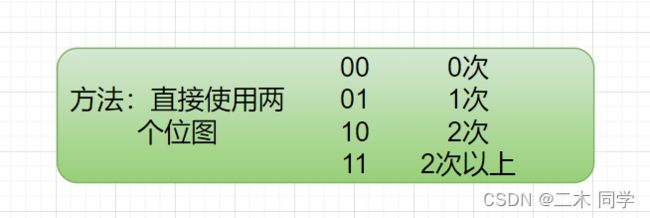【C++】哈希应用:bitset和布隆过滤器
一、位图概念
一道面试题:
给定40亿个无序不重复的无符号整数。给一个无符号整数,如何快速判断一个数是否在这40亿个数中
- 遍历,时间复杂度 O ( N ) O(N) O(N)
- 排序: O ( N l o g N ) O(NlogN) O(NlogN),利用二分查找: l o g N logN logN
- 位图解决
数据是否在给定的整形数据中,结果是在或者不在,刚好是两种状态,那么可以使用一个二进制比特位来代表数据是否存在的信息,如果二进制比特位为1,代表存在,为0代表不存在。
所谓位图,就是用每一位来存放某种状态,适用于海量数据,数据无重复的场景。通常是用来判断某个数据存不存在的
二、bitset的使用
bitset使用文档
- 构造
bitset<32> b1;// 0
bitset<32> b2(-1);// 4294967295
bitset<32> b3("1010");// 10
cout << b1.to_ulong() << endl;// 转换成无符号长整型
cout << b2.to_ulong() << endl;
cout << b2 << endl;// 直接输出二进制表示
cout << b3.to_ulong() << endl;
cout << b3.to_string() << endl;// 转换成字符串
- 访问
| 函数 | 说明 |
|---|---|
| operator[](size_t pos) | 返回pos位置的bit(1或0) |
| count | 返回1的个数 |
| size | 返回位图大小 |
| test(size_t pos) | pos位置是1返回true,0返回false |
| any | 全0返回false,否则返回true |
| all | 全1返回true,否则返回false |
| none | 全0返回true,否则返回false |
- 操作
| 函数 | 说明 |
|---|---|
| set(size_t pos, bool val = true) | 将pos位置设置为val |
| reset(size_t pos) | 将pos位置设置为0 |
| flip(size_t pos) | pos位置取反 |
三、bitset的模拟实现
// 非类型模板参数
template<size_t N>
class bitset
{
public:
bitset()
{
// 加一个字节避免 20 / 8 = 2访问20时越界
//_bits.resize(N / 8+1, 0);// 1个字节8个比特位
_bits.resize((N >> 3) + 1, 0);// 注意运算符优先级
}
void set(size_t pos)
{
//size_t i = pos / 8;
size_t i = pos >> 3;// 在第i个char
size_t j = pos % 8;// 第i个char的第j个比特
_bits[i] |= (1 << j);
}
void reset(size_t pos)
{
size_t i = pos >> 3;
size_t j = pos % 8;
_bits[i] &= (~(1 << j));
}
bool test(size_t pos)
{
size_t i = pos >> 3;
size_t j = pos % 8;
//return (_bits[i] >> j) & 1;
return _bits[i] & (1 << j);
}
private:
std::vector<char> _bits;
};
四、布隆过滤器
1、提出
我们在使用新闻客户端看新闻时,它会给我们不停地推荐新的内容,它每次推荐时要去重,去掉那些已经看过的内容。问题来了,新闻客户端推荐系统如何实现推送去重的?
用服务器记录了用户看过的所有历史记录,当推荐系统推荐新闻时会从每个用户的历史记录里进行筛选,过滤掉那些已经存在的记录。 如何快速查找呢?
-
用哈希表存储用户记录
缺点:浪费空间 -
用位图存储用户记录
缺点:位图一般只能处理整形,如果内容编号是字符串,就无法处理 -
将哈希与位图结合,即布隆过滤器
2、概念
布隆过滤器是由布隆(Burton Howard Bloom)在1970年提出的 一种紧凑型的、比较巧妙的概率型数据结构,特点是高效地插入和查询,可以用来告诉你 “某样东西一定不存在或者可能存在” ,它是用多个哈希函数,将一个数据映射到位图结构中。此种方式不仅可以提升查询效率,也可以节省大量的内存空间
3、查找
布隆过滤器的思想是将一个元素用多个哈希函数映射到一个位图中,因此被映射到的位置的比特位一定为1。所以可以按照以下方式进行查找:分别计算每个哈希值对应的比特位置存储的是否为零,只要有一个为零,代表该元素一定不在哈希表中,否则可能在哈希表中。
注意:布隆过滤器如果说某个元素不存在时,该元素一定不存在,如果该元素存在时,该元素可能存在,因为有些哈希函数存在一定的误判。
比如:在布隆过滤器中查找"Tencent"时,假设3个哈希函数计算的哈希值为:2、4、6,刚好和其他元素的比特位重叠,此时布隆过滤器告诉该元素存在,但实际该元素是不存在的。
4、删除
布隆过滤器不能直接支持删除工作,因为在删除一个元素时,可能会影响其他元素。
比如:删除"tencent"元素,如果直接将该元素所对应的二进制比特位置0, “baidu”元素也被删除了,因为这两个元素在多个哈希函数计算出的比特位上刚好有重叠。
一种支持删除的方法:将布隆过滤器中的每个比特位扩展成一个小的计数器,插入元素时给k个计数器(k个哈希函数计算出的哈希地址)加一,删除元素时,给k个计数器减一,通过多占用几倍存储 空间的代价来增加删除操作。
缺陷:
- 无法确认元素是否真正在布隆过滤器中
- 存在计数回绕(删除时减少的计数被插入增加回来)
5、优缺点
- 优点
- 增加和查询元素的时间复杂度为 O ( K ) O(K) O(K), ( K K K为哈希函数的个数,一般比较小),与数据量大小无关
- 哈希函数相互之间没有关系,方便硬件并行运算
- 布隆过滤器不需要存储元素本身,在某些对保密要求比较严格的场合有很大优势
- 在能够承受一定的误判时,布隆过滤器比其他数据结构有着很大的空间优势
- 数据量很大时,布隆过滤器可以表示全集,其他数据结构不能
- 使用同一组散列函数的布隆过滤器可以进行交、并、差运算
- 缺陷
- 有误判率,即存在假阳性(False Position),即不能准确判断元素是否在集合中(补救方法:再建立一个白名单,存储可能会误判的数据)
- 不能获取元素本身
- 一般情况下不能从布隆过滤器中删除元素
- 如果采用计数方式删除,可能会存在计数回绕问题
6. 模拟实现
#pragma once
#include 五、海量数据面试题
1、位图应用
- 给定100亿个整数,设计算法找到只出现一次的整数?
template<size_t N>
class twobitset
{
public:
void set(size_t x)
{
if (!_bs1.test(x) && !_bs2.test(x)) // 00 --> 01 0次变成1次
{
_bs2.set(x); // 01
}
else if (!_bs1.test(x) && _bs2.test(x)) // 01 --> 1次变成1次以上
{
_bs1.set(x);
_bs2.reset(x); // 10
}
// 10 1次以上不做处理
}
void PirntOnce()
{
for (size_t i = 0; i < N; ++i)
{
// 01是出现一次
if (!_bs1.test(i) && _bs2.test(i))
{
cout << i << endl;
}
}
cout << endl;
}
private:
bitset<N> _bs1;
bitset<N> _bs2;
};
void test_twobitset()
{
twobitset<100> tbs;
int a[] = { 1, 2, 3, 4, 4, 5, 5, 99, 22 };
for (auto e : a)
{
tbs.set(e);
}
tbs.PirntOnce();
}
- 给两个文件,分别有100亿个整数,我们只有1G内存,如何找到两个文件交集?
假设这里的整数范围不超过32位整数范围。分别开两个位图,42亿个比特位表示每个整数是否存在,每个位图约0.5G(1GB约10亿字节80亿比特,1MB约100万字节),两个位图都存在的数则为交集。
2、哈希切割
- 给一个超过100G大小的log file, log中存着IP地址, 设计算法找到出现次数最多的IP地址?
A i A_i Ai小文件超过1G怎么办?
情况1: 小文件中冲突的ip很多,都是不同的ip,大多数是不重复的。map统计不下。换个字符串哈希函数,递归再切分。
情况2:小文件中冲突的ip很多,大多都是相同的ip,大多数是重复。map可以统计
如何区分这两种情况?
情况1下map会因内存不足,insert失败,new节点抛异常。通过捕获异常就能区分两种情况
- 与上题条件相同,如何找到top K的IP?如何直接用Linux系统命令实现?
3、布隆过滤器
- 给两个文件,分别有100亿个query,我们只有1G内存,如何找到两个文件交集?分别给出精确算法和近似算法
精确算法与上面的哈希切割问题解决办法大致相同:
近似算法:
使用 Bloom Filter 算法找到两个文件的交集的步骤:
- 从第一个文件中读取所有查询,并将每个查询插入 Bloom Filter 中。
- 从第二个文件中读取所有查询,并检查每个查询是否在 Bloom Filter 中。
- 如果查询存在于 Bloom Filter 中,则是交集输出查询并继续处理下一个查询。
- 如果查询不存在于 Bloom Filter 中,则继续处理下一个查询。
- 如何扩展BloomFilter使得它支持删除元素的操作
可行的方法是加计数器但是空间消耗大。
参考博客:
- 详解布隆过滤器的原理
- 字符串Hash函数对比





